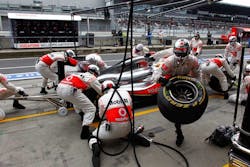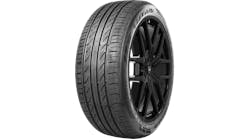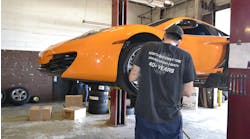Hamilton beat Webber off the line, with the entire field starting on the P Zero Yellow soft tires. Webber took the lead by pitting early for another set of soft tires on lap 14 in order to pre-empt both Hamilton and Alonso, who were running in close formation.
The Red Bull driver was the first of the leading trio to change tires again on lap 30, but Hamilton stopped just one lap later and came out right next to the Australian, claiming the lead after a fierce battle at the first corner. Alonso tried the same tactic on lap 32 and also emerged in the thick of the leading battle, before Hamilton gained the advantage once again.
The top three all stopped three times in total and used the same strategy of three initial stints on the soft tire and the final stint on the P Zero White medium tire. With the soft tires expected to be more than a second a lap quicker than the medium tires in the cool temperatures of 55.4 degrees Fahrenheit, and a constant threat of rain, the drivers tried to stay out for as long as possible on the P Zero Yellow tire, putting the emphasis on tactics.
Hamilton was the first to make his final stop onto the medium rubber with nine laps to go. Alonso pitted two laps later, slotting in just behind Hamilton – who had quickly got up to racing speed on the P Zero White tires. Adrian Sutil was the highest-placed driver to adopt a two-stop strategy, securing his best finish of the year with sixth place at his home grand prix.
Pirelli’s motorsport director Paul Hembery commented: “The whole race hinged on tire strategy, as we saw Hamilton, Alonso and Webber all try to use pit stops to their advantage. Although some people were thinking that there would be a big time gap between the soft and the medium tire, Lewis Hamilton was able to win the race in style after being the first of the front runners to change onto the P Zero White tire. We saw a wide spread of strategies once more, with two drivers even delaying their final pit stop until the very last lap. Because of the cool temperatures and smooth surfaces we saw the tires lasting for a very long time here, which makes an interesting contrast to the early part of the year when some people said that our tires weren’t lasting long enough! This underlines not only how quickly all the teams and drivers get to grips with their equipment in Formula One, but also just how complex our brief is as the tire supplier. Despite that, we’ve seen three pit stops per car, which is exactly what we were aiming for.”



